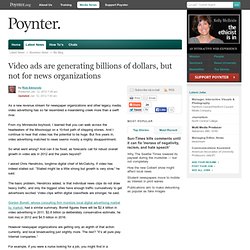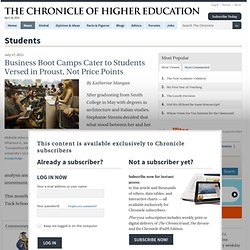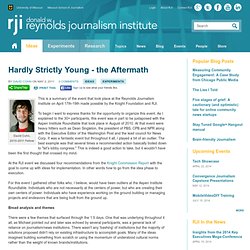

Video ads are generating billions of dollars, but not for news organizations. As a new revenue stream for newspaper organizations and other legacy media, video advertising has so far resembled a meandering creek more than a swift river.

From my Minnesota boyhood, I learned that you can walk across the headwaters of the Mississippi on a 10-foot path of stepping stones. And I continue to hear that video has the potential to be huge. But five years in, video advertising matched to news seems mostly a mighty disappointment. So what went wrong? And can it be fixed, as forecasts call for robust overall growth in video ads in 2012 and the years beyond? I asked Chris Hendricks, longtime digital chief of McClatchy, if video has indeed stalled out. The basic problem, Hendricks added, is that individual news clips do not draw heavy traffic, and only the biggest sites have enough traffic cumulatively to get advertisers excited.
Gordon Borrell, whose consulting firm monitors local digital advertising market by market, had a similar summary. Are there signs of hope? Business Boot Camps Cater to Students Versed in Proust, Not Price Points - Students. July 17, 2011 Silas Crews for The Chronicle Michelle Velez (center), a rising sophomore at Villanova U., works on a group project for her "Competitive Effectiveness" class at the university's 10-week Summer Business Institute.

Enlarge Image By Katherine Mangan After graduating from Smith College in May with degrees in architecture and Italian studies, Stephanie Strenta decided that what stood between her and her dream job was a basic grasp of business. So like a growing number of liberal-arts and sciences majors, she performed a cost-benefit analysis and decided that a summer business boot camp was a sound investment. This month she completed a four-week program at Dartmouth College's Tuck School of Business, where, for just under. Bulletins from the future. Making news pay: Reinventing the newspaper. How newspapers are faring: A little local difficulty.
News21: Carnegie-Knight Initiative on the Future of Journalism Education. The Young Turks: Rebel Headquarters : News : Politics : Commentary. Introduction. The End Of The Destination Web And The Revival Of The Information Economy. In recent weeks journalism and the future of all media have once again gone under the knife.

Experts on either side of new media debated whether or not Twitter's CNN moment truly was indicative of the future of journalism. Twitter's role in the spread of online dialogue speculating the death of Osama Bin Laden was studied at great depths to better understand when and where news actually surfaces, how it's validated, and how news travels across the Web and in real life.
Perhaps nothing visualized the power of a single Tweet with such dramatic effect as the network graph developed by SocialFlow. Twitter is becoming a veritable human seismograph as it measures and records events as they unfold. But for this discussion, I'd like to focus not on the future of journalism, but instead on human behavior and the reality of the social effect.
The End of the Destination Web and the Revival of the Information Economy In hindsight, the days of Web 1.0 seem like an era long gone. This.Just.In 1. 2. 3. Hardly Strictly Young - the Aftermath. David Cohn, 2010-2011 Fellow This is a summary of the event that took place at the Reynolds Journalism Institute on April 17th-19th made possible by the Knight Foundation and RJI.

To begin I want to express thanks for the opportunity to organize this event. As I explained to the 30+ participants, this event was in part to be juxtaposed with the Aspen Institute Roundtable that took place in August of 2010. At that event were heavy hitters such as Dean Singleton, the president of PBS, CPB and NPR along with the Executive Editor of the Washington Post and the lead council for News Corp.
It was a fantastic event but throughout it all, I played a bit of an outlier. At the RJI event we discussed four recommendations from the Knight Commission Report with the goal to come up with ideas for implementation. For this event I gathered other folks who, I believe, would have been outliers at the Aspen Institute Roundtable. Broad analysis and themes.
The TWiT Netcast Network with Leo Laporte. Newspapers: Missed the 2010 Media Rally. By Rick Edmonds of the Poynter Institute, Emily Guskin and Tom Rosenstiel of Project for Excellence in Journalism.

For newspapers, 2010 was comparatively calm after the hair-raising revenue dips of 2008 and 2009. That was cold comfort, however, to an industry still laboring to find a sustainable business model for the future. In a year when most other media businesses rallied, advertising revenues at newspaper organizations continued to fall – roughly 6.3% for the year. That compares to a drop of 26% in 2009.
Print circulation also continued to decline, 5% daily and 4.5% Sunday year-to-year for the six-month period ending September 30. Still, contrary to what those who have already written print’s obituary may think, newspapers generally were still operating in the black. Online audience, though imprecisely measured, did grow some, and many papers can claim their overall audience is growing. There is a modest upside for newspapers this time, however.
Now the model has shifted again.